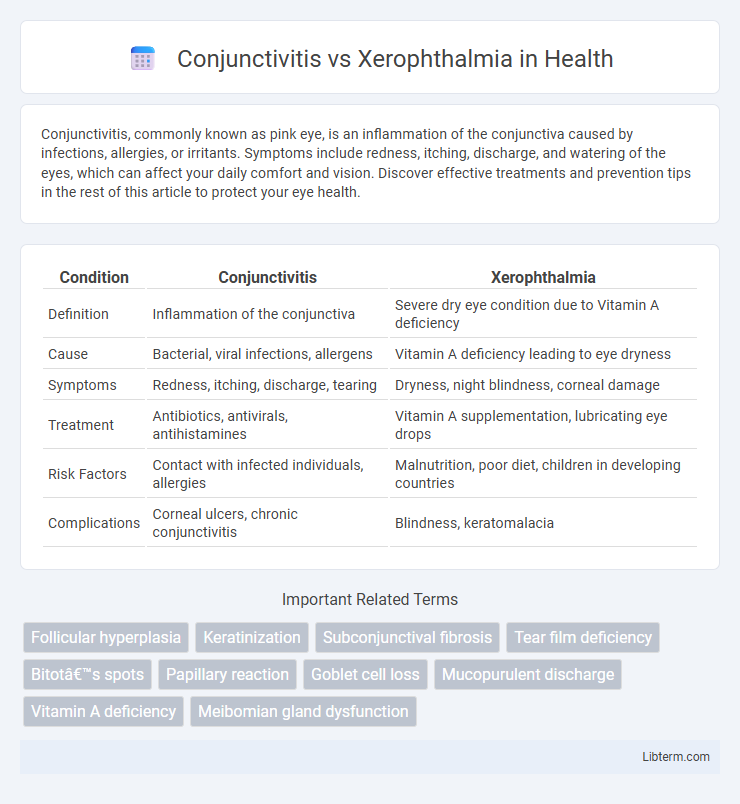Conjunctivitis, commonly known as pink eye, is an inflammation of the conjunctiva caused by infections, allergies, or irritants. Symptoms include redness, itching, discharge, and watering of the eyes, which can affect your daily comfort and vision. Discover effective treatments and prevention tips in the rest of this article to protect your eye health.
Table of Comparison
| Condition | Conjunctivitis | Xerophthalmia |
|---|---|---|
| Definition | Inflammation of the conjunctiva | Severe dry eye condition due to Vitamin A deficiency |
| Cause | Bacterial, viral infections, allergens | Vitamin A deficiency leading to eye dryness |
| Symptoms | Redness, itching, discharge, tearing | Dryness, night blindness, corneal damage |
| Treatment | Antibiotics, antivirals, antihistamines | Vitamin A supplementation, lubricating eye drops |
| Risk Factors | Contact with infected individuals, allergies | Malnutrition, poor diet, children in developing countries |
| Complications | Corneal ulcers, chronic conjunctivitis | Blindness, keratomalacia |
Introduction to Eye Health Conditions
Conjunctivitis and xerophthalmia are common eye health conditions affecting the conjunctiva and tear film, respectively. Conjunctivitis, characterized by inflammation and redness, often results from infections or allergens, impacting the eye's surface and causing discomfort. Xerophthalmia, associated with vitamin A deficiency, leads to dryness and impaired tear production, potentially causing severe vision problems if untreated.
Overview of Conjunctivitis
Conjunctivitis, commonly known as pink eye, is an inflammation or infection of the conjunctiva--the transparent membrane covering the white part of the eye and inner eyelids--resulting in redness, itching, and discharge. It can be caused by bacterial or viral infections, allergens, or irritants, making it highly contagious in infectious forms. Treatment varies from antibiotic eye drops for bacterial conjunctivitis to antihistamines for allergic types, emphasizing the importance of accurate diagnosis to prevent complications.
Overview of Xerophthalmia
Xerophthalmia is a progressive eye condition caused by severe vitamin A deficiency, leading to dryness of the conjunctiva and cornea, and can result in night blindness and corneal ulceration. Unlike conjunctivitis, which is primarily an inflammation due to infection or allergy, xerophthalmia involves the degeneration of mucous membranes and epithelial cells in the eyes. Early detection and vitamin A supplementation are crucial to prevent permanent vision loss associated with xerophthalmia.
Key Causes of Conjunctivitis
Conjunctivitis is primarily caused by viral or bacterial infections, allergens, and irritants such as smoke or chemicals, leading to inflammation of the conjunctiva. Xerophthalmia results from vitamin A deficiency, causing dryness and keratinization of the conjunctiva and cornea. Unlike xerophthalmia, conjunctivitis often involves contagious pathogens like adenoviruses or Staphylococcus aureus, making infection control crucial.
Primary Causes of Xerophthalmia
Xerophthalmia primarily results from severe vitamin A deficiency, leading to the drying and thickening of the conjunctiva and cornea. This condition is often associated with malnutrition, especially in children living in developing countries with inadequate dietary intake of vitamin A or malabsorption disorders. Unlike conjunctivitis, which is commonly caused by bacterial or viral infections, xerophthalmia involves a nutritional deficiency that impairs tear production and ocular surface health.
Common Symptoms Comparison
Conjunctivitis commonly presents with redness, itching, and discharge from the eyes, often accompanied by a gritty sensation and excessive tearing. Xerophthalmia is characterized by dryness, thick mucus discharge, and night blindness due to vitamin A deficiency, leading to corneal damage in severe cases. Both conditions involve eye discomfort and impaired vision but differ significantly in underlying causes and specific symptom profiles.
Diagnostic Methods for Both Conditions
Diagnostic methods for conjunctivitis primarily involve clinical examination, including slit-lamp evaluation to identify inflammation, discharge, and conjunctival redness, alongside bacterial or viral cultures when infection is suspected. Xerophthalmia diagnosis relies on assessing tear film stability via Schirmer's test and tear breakup time, supported by ocular surface staining techniques such as fluorescein and Rose Bengal to detect corneal and conjunctival damage caused by vitamin A deficiency. Both conditions may require differential diagnosis through careful evaluation of symptoms, patient history, and targeted laboratory tests to confirm underlying causes and guide appropriate treatment.
Treatment Options: Conjunctivitis vs Xerophthalmia
Treatment options for conjunctivitis primarily include antibiotic or antiviral eye drops for bacterial or viral infections, along with antihistamines for allergic conjunctivitis, emphasizing symptom relief and infection control. Xerophthalmia treatment focuses on vitamin A supplementation to address deficiency, along with lubricating eye drops and managing underlying causes to prevent corneal damage and restore tear production. Prompt and targeted therapy in conjunctivitis prevents infection spread, while vitamin A administration in xerophthalmia is critical to avoid irreversible blindness.
Prevention Strategies for Eye Health
Effective prevention strategies for conjunctivitis include maintaining proper hygiene by regularly washing hands, avoiding touching the eyes, and using clean towels and bedding to reduce the risk of infection. Xerophthalmia prevention focuses on nutritional interventions, particularly ensuring adequate vitamin A intake through diet or supplementation to prevent severe dryness and vision impairment. Both conditions benefit from avoiding environmental irritants, wearing protective eyewear, and seeking timely medical treatment to maintain overall eye health.
When to Seek Medical Attention
Seek medical attention for conjunctivitis if symptoms include intense redness, swelling, pain, or vision changes, as bacterial or viral infections may require specific treatments. Xerophthalmia demands urgent care when experiencing persistent dryness, night blindness, or thick eye discharge, often linked to vitamin A deficiency and risk of corneal damage. Early diagnosis and management are crucial to prevent complications and preserve eye health in both conditions.
Conjunctivitis Infographic

 libterm.com
libterm.com